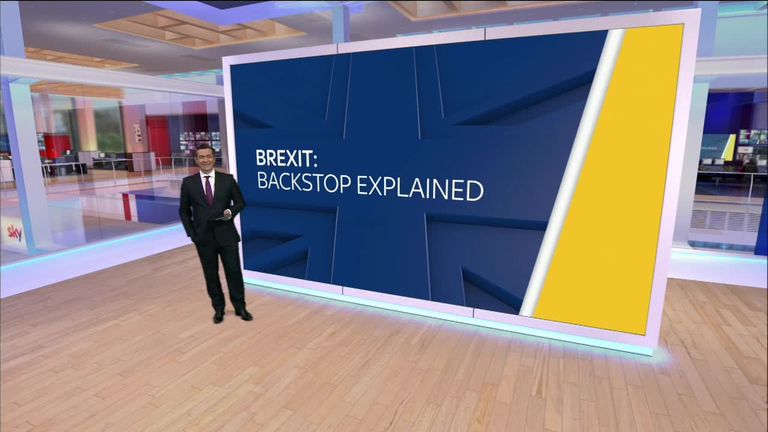Technological solution to Irish border issue could be a decade away, says Home Office document
A Home Office presentation says a solution which would keep the border open without checkpoints is a distant prospect.
Wednesday 17 April 2019 18:17, UK
The possibility of a technological solution to the Brexit Northern Ireland border issue could be more than a decade away, according to a Home Office document seen by Sky News.
A presentation drawn up by the Home Secretary's Policy Unit and sent to HMRC and the Treasury implies that they think a technological solution - which would aim to keep the Irish border entirely open and without physical checkpoints - is a distant (and likely very expensive) prospect.
The authors state that the technology would likely not be ready to be deployed in the UK until 2030.
A technological solution to the Irish border quagmire has been much trumpeted by Brexiteers for months, if not years.
It has been at the centre of Tory efforts to find an alternative to the much hated "Irish backstop", which would involve a basic customs union for the whole of the UK with the EU and Northern Ireland moving closer to EU regulations on goods.
That would keep the border open but at a cost, its detractors say, of diluting Brexit and keeping Britain in a trading regime against its will.
The report does come up with a solution, albeit a highly complicated one.
It involves companies uploading data into a digital portal, using new blockchain technology, sensors and "Internet of things technology" along the route, "machine learning" and automated revenue collection.
"If all these technologies are brought together this could allow a seamless collection and analysis of the data needed," the presentation says. "It would also provide the ability to target interventions away from the border itself."
However, the presentation's authors acknowledge that the practical execution of such technology would be far from seamless.
They say that "no government worldwide currently controls different customs arrangements with no physical infrastructure at the border."
They believe that "technology does already exist that could be used at the border to the desired effect" but also highlights five grave practical problems in terms of actually deploying it. They are:
:: The system "must operate with 28 government agencies and a myriad of interconnected existing and planned IT systems".
:: "There is currently no budget for either a pilot or the programme itself. And it will be expensive."
:: "The suite of technology would need to operate on both sides of the border, as such it would require agreement and commitment from Northern Ireland, the Republic of Ireland and the EU too."
:: "It is a big and complex project, with possibly tight deadlines. Government does not have the strongest track record on delivery of large tech projects."
:: And crucially - "Current realisation for a similar technological solution in the UK is 2030."
Given those constraints, the prospect of any imminent rollout (if ever) seems remote.
The last point, on timescale, is especially significant given that should the prime minister's withdrawal agreement pass, the government would only have until December 2020 to devise arrangements to keep the border open and without checkpoints, otherwise the UK would fall into the backstop regime.
It seems likely that if it is passed that is what will happen.
Home Secretary Sajid Javid, likely with this report in mind, said in February: "In terms of an alternative arrangements it can be done.
"In my own department I've got Border Force. I asked Border Force months ago to advise me what alternative arrangements are possible and they've shown me quite clearly that you can have no hard border on the island of Ireland and you can use existing technology the only thing missing is a bit of goodwill."
The technology might exist but as this presentation clearly says it will take much more than goodwill for any tech solutions to solve anything on the Irish border.





